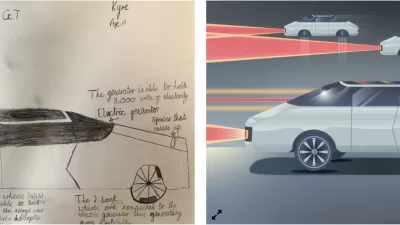Planners often encounter ineffective public participation because of the fact that citizens often are not taught planning skills in school, says Michael A. Rodriguez.
Planners who have ever taken part of a public meeting know that the lack of planning knowledge out there is astounding – but we should not be surprised.
The fact is, when are students in K – 12 education ever taught planning concepts? Most of social studies, civics, and government is spent on history, federal government institutions, and world geography. Excuse my bias, but local government and planning are critical to the everyday lives of students. Moreover, neighborhoods are a particularly relatable concept that students in K – 12 can understand and use to engage in many subjects.

This is why I argue that the vocabulary of planning and the concepts necessary to participate in local government and planning issues need to be taught to students in K-12. If we assume students will achieve this in college we do a disservice to those who are not college-bound. Programs such as the Center for Understanding the Built Environment's (CUBE) "Box Cities" program are a great opportunity to get K-12 students learning these concepts. Teaching students about the built environment and its institutions enhances students' ability to be an effective citizen and participate in an aspect that significantly influences their everyday life.
The problem is a lack of capacity among the citizenry to engage in planning issues on equal footing with other stakeholders. How can residents of a community truly understand a long-range plan if they cannot grasp the maps presented? We might take map-reading for granted, but in an era of standardized tests focus and heavy emphasis on math and reading, students lose the time to learn skills like identifying a location on a map and orienting cardinal directions.
My good friend who is a high-school history teacher tells me horror stories of how her students (in 11th grade) had no idea how to read a map of Europe – in a World History class! Simply, they could not differentiate ocean from land, or one country from another. So imagine these students attempting to engage in planning in a few years.
Not all students everywhere are in this situation (she is a teacher in the South Bronx). But even so, there is more than map reading necessary for planning engagement. Design vocabulary ('scale', 'rhythm,' 'walkability,' 'density') and social vocabulary ('mobility,' 'sense of place,' 'community values,' 'housing equity' ) are necessary for planning participation. The concepts of a neighborhood, land uses, home consumption, commercial enterprise, and transportation networks need to be taught. These are not concepts we grasp inuitively; our schools have an obligation teach them and prepare an effective citizenry.
One way that I've become active in this field is in taking part of the Box Cities program. While I was a planning graduate student in Madison, Wisconsin, I took part in 'Terrace Town,' a program where grade school children build a city out of boxes and art supplies and present them in a fun day at Monona Terrace, Madison's convention center. I mentored a first-grade class, and was astounded and humbled by their ability to learn and apply planning concepts. They built homes, civic, industrial and commercial structures out of milk cartons and shoe boxes. They placed the structures along transportation networks, and built a rail system in their city. They separated uses when they felt it made sense (like keeping the airport away from houses). Students were also taught 'green' concepts, and built alternative energy infrastructure like windmills. And these were first graders! There were middle-school students whose 'box city' blew me away, and should be a model for progressive urban development.
To the nay-sayers who do not think schools have time to teach planning concepts, or worry more about 'core' curricula in math, science, and reading, I say that teaching planning concepts is fun and complimentary to teaching other subjects. They are not mutually exclusive. Teaching the concept of scale obviously includes math. Learning about one's city and neighborhood, and keeping a journal about the community, requires reading and writing exercises. CUBE has built an entire curriculum around this, and I urge you to look at it and contact them because there are lessons that incorporate planning concepts into almost any subject.
I am doing my part by engaging grade school students and trying to bring Box Cities to the Washington, D.C. area where I now live. Another way to be engaged is to be active in your children's school and try to convince teachers and administrators to teach these concepts, or incorporate curricula like Box Cities. Finally, books like Where Things Are, From Near to Far, The Works: Anatomy of a City, and City Works: Exploring Your Community: A Workbook are great for exposing children to the ideas of the built environment. Let's teach children planning, and lets create a solid generation of planning participants.
Michael A. Rodriguez is a Transportation Analyst with Cambridge Systematics in Bethesda, MD. He is also actively engaged with the Center for Understanding the Built Environment (CUBE) and teaching planning concepts to children.

Planetizen Federal Action Tracker
A weekly monitor of how Trump’s orders and actions are impacting planners and planning in America.

Maui's Vacation Rental Debate Turns Ugly
Verbal attacks, misinformation campaigns and fistfights plague a high-stakes debate to convert thousands of vacation rentals into long-term housing.

San Francisco Suspends Traffic Calming Amidst Record Deaths
Citing “a challenging fiscal landscape,” the city will cease the program on the heels of 42 traffic deaths, including 24 pedestrians.

Defunct Pittsburgh Power Plant to Become Residential Tower
A decommissioned steam heat plant will be redeveloped into almost 100 affordable housing units.

Trump Prompts Restructuring of Transportation Research Board in “Unprecedented Overreach”
The TRB has eliminated more than half of its committees including those focused on climate, equity, and cities.

Amtrak Rolls Out New Orleans to Alabama “Mardi Gras” Train
The new service will operate morning and evening departures between Mobile and New Orleans.
Urban Design for Planners 1: Software Tools
This six-course series explores essential urban design concepts using open source software and equips planners with the tools they need to participate fully in the urban design process.
Planning for Universal Design
Learn the tools for implementing Universal Design in planning regulations.
Heyer Gruel & Associates PA
JM Goldson LLC
Custer County Colorado
City of Camden Redevelopment Agency
City of Astoria
Transportation Research & Education Center (TREC) at Portland State University
Jefferson Parish Government
Camden Redevelopment Agency
City of Claremont





























